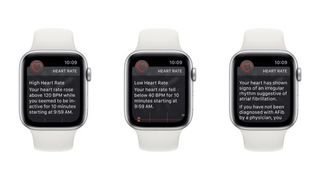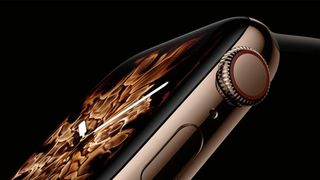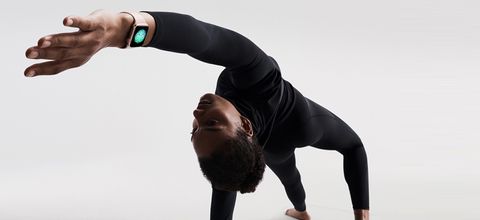Our Verdict
The Apple Watch has taken a great leap forward with the Series 4, with hardware upgrades like the bigger screen and the improved heart rate monitor complemented by the release of watchOS 5, which brings several useful fitness features. Apple’s everyday activity tracking is as good as it gets and when you do find something that the Watch’s native software lacks, there is almost always an app available to solve your problem.
For
- Larger screen
- Improved heart rate monitor
- Top-notch everyday tracking
- Arrival of podcasts
Against
- No native sleep tracking
- Native workout tracking still lacks depth
- No always-on screen option
You can trust Coach
Tracking Activity With The Apple Watch Series 4
Nothing has changed here from past Apple Watches, but when you have a system this good there’s no need to mess with it. There are three activity goals – Move, Exercise and Stand – and corresponding rings are filled as you progress towards completing each one. While I’ll happily ignore Fitbit and Garmin reminders to move, I always feel I’ve got to fill Apple’s rings.

The red Move ring represents your active calories – those burned through moving around and exercising – and it can be set to any value you like, with the standard being 500. At the start of each week the Watch will recommend a new goal based on the previous week’s activity.
The green Exercise ring fills when you complete 30 minutes of activity each day. That target is fixed, as is the 12-hour Stand goal, represented by the blue ring. The latter is the only goal you can’t hit just by working out that day, because you have to move around at some point within each hour to get a point towards your goal. You get reminders to move at ten minutes to the hour if you’ve been sedentary for the past 50 minutes.
If you need an extra nudge to make sure you fill your rings, Apple provides coaching tips throughout the day. These might be a suggestion of what activity you need to do to complete your rings, like a 15-minute walk, or a mild scolding that you are normally closer to filling your rings at that point of the day. You can also compete against fellow Apple Watch wearers over seven days to see who does the best job of filling their rings, if that’ll help motivate you.
The rings system is simple and very engaging, and you can add the rings to your watch face either as a small icon or a larger part of the dial itself to keep yourself motivated.
Running With The Apple Watch Series 4
The arrival of watchOS 5 brought some notable improvements for runners, including cadence (stride rate) and rolling pace stats. The latter is particularly useful, showing your pace over the last mile or kilometre. This is a more accurate way to gauge your pace than a current pace stat, because that tends to jump around a lot with GPS devices. You can also set a pace target and get alerts from the Watch if you’re running too fast or too slow.
Apple has also added auto recognition of runs so you don’t have to manually start a session – the Watch will detect that you are running and buzz at you to ask if you want to start tracking it. I found this usually kicked in between 500m and 1km into a run, with the distance you’ve already covered included when you respond to the prompt.
In addition, the Apple Watch will also alert you if you forget to stop tracking, so your average pace isn’t knocked out of whack because you sat down for five minutes before remembering to press the finish button.
However, these improvements are largely redundant for anyone who wants to sync their runs to another app like Strava, because Apple doesn’t make that easy. It can be done by faffing around with third-party apps like RunGap that can access the workout data and send it elsewhere, but this is a pain and can be costly.
While there are plenty of running apps available on the Apple Watch, including all the big-hitters like Strava, Nike+ Run Club and Runkeeper, these are still quite basic – you get key stats like distance, pace, time and heart rate, and not much else.
That’s fine for the casual runner, but if you’re looking for the features of a running watch – like customisable interval workouts and more detailed stats – the Apple Watch is a let-down. There are apps that do provide these features, like the impressive iSmoothRun, but the experience is still not as slick as using a Garmin Forerunner, for example.
Beyond that, one minor annoyance that has existed with every version of the Apple Watch remains – the lack of an always-on screen option. This means you have to raise your wrist towards your face or tap the screen to see your running stats, rather than just glancing down.
I also noticed that when I ran with my phone and the Apple Watch, the GPS tracking was not as accurate as when running with the watch alone. The Watch will piggyback off your phone’s GPS if it’s nearby and this tends to lead to excessive smoothing of your route – cutting corners through buildings and the like – with the result that your overall run is shorter. It’s not a huge issue, but worth noting if you’re building up for a race and trying to hit a certain pace with your training runs.
Working Out With The Apple Watch Series 4
There are more sports modes than ever before in the native Workouts app, with watchOS 5 bringing yoga and hiking options to the table. Other workout options include functional training, HIIT, all the usual cardio machines and table tennis (but no other racket sports). For most of these you get basic stats like time and calories burned. Presumably there are different algorithms at play behind the scenes that decide how many more calories table tennis burns than yoga, with your heart rate feeding in to them.
As mentioned above there is no basic intervals mode, which would be really useful for many, but just as with running you can solve this problem with a third-party app. There are amazing yoga (Pocket Yoga), gym (Gymaholic), and intervals (Intervals) apps that do far more than Apple’s Workouts app, so it’s worth researching the best apps for your preferred activity to upgrade your experience with the Watch.
There are also many apps out there that will guide you through workouts, which is a real strength of the Apple Watch. Sworkit and Seven are two such apps, with both providing the exercises you should do and how long you should do them for, with pictures on the watch screen showing the correct form for the exercise.
Other smart wearables offer similar features to the above: Fitbit has its own Fitbit Coach built into the Versa and Ionic smartwatches, and Wear OS devices have an impressive app store to tap into themselves. Still, I’d back Apple’s array of workout apps as the most varied and best integrated.
Heart Rate Tracking On The Apple Watch Series 4
The Apple Watch’s lack of accuracy with heart rate tracking during exercise has been a bugbear of mine with previous generations, to the point where I’d generally turn it off entirely, because I’ll take extra battery life over inaccurate data any day. However, with the Series 4 those problems seem to have been solved. The Watch tracked my heart rate reliably throughout a variety of workouts and throughout the day.
That’s particularly good news because Apple has introduced several new features, including alerts if your heart rate drops to an unusually low level, to go along with the existing alert if it rises to an unexpectedly high level when not exercising. These didn’t kick in for me at any point, thankfully, but the alerts could be a way to detect any irregularities with your heart rate that should be checked out.

One of the headline features of the new Watch is the ability to take an electrocardiogram through the new ECG app, but this is only currently available in the USA, where the Watch is an FDA-approved medical device. However, everyone gets access to the new fall detection feature, which uses the accelerometer and gyroscope in the watch to detect if you’ve taken a tumble. More than a tumble actually, a hard fall, which will hopefully avoid false positives because a fall brings up the option to call emergency services with a quick swipe, and the Watch will make the call automatically if you are unresponsive for 60 seconds as well as messaging your emergency contacts. The feature is off by default, but could literally be a lifesaver.
The Apple Watch also provides information on how quickly your heart rate returns to normal after you finish exercising, with a faster recovery rate being an indication of good health. It’s something to check occasionally in the Activity app to see if your fitness is improving, as is your resting heart rate, which is another solid indicator of your overall cardiovascular fitness.
RECOMMENDED: Best Heart Rate Monitors
Cycling With The Apple Watch Series 4
If not having an always-on face available for running is annoying, it’s downright infuriating for cycling, when a deliberate movement to lift your hand off the handlebars is all the more awkward. Aside from that extra irritation the Apple Watch’s cycling capabilities are similar to running, with the native Workouts app offering basic stats and an array of third-party apps like Strava and Cyclemeter providing more detail.
The Apple Watch does link with Bluetooth heart rate straps if you want to use one while on the bike, but it doesn’t connect to ANT+ sensors and also won’t connect to any kind of power or cadence sensors.
Swimming With The Apple Watch Series 4
Both indoor and outdoor swims are tracked on the Apple Watch, and with the latter the GPS is engaged so you get a map of your swim in the Activity app on your phone afterwards. With either type of swimming the Apple Watch will also log how many metres you swim for each different kind of stroke you use and break it down for you on the watch afterwards. I found this to be fairly accurate but not infallible, and that’s not just down to my amateurish swimming technique – I asked a proficient swimmer to try it and there were still some errors in recognising the stroke they used.
Once again there are some third-party apps to consider, including MySwimPro which you can use to set up workouts to follow while swimming, but the native swim tracking is done well on the Apple Watch.
There is also a multisport mode of sorts where you can choose to directly switch to another sport instead of just finishing your session in the Workouts app. It’s not equivalent to a traditional triathlon mode because the activities will be recorded separately and you don’t get transition times, but it’s handy if you’re in the gym switching between different type of exercise.
RECOMMENDED: Best Waterproof Fitness Trackers
Listening To Music And Podcasts On The Apple Watch Series 4
As someone who runs most days and almost exclusively listens to podcasts while running, I considered the lack of native support for podcasts on past Apple Watches borderline criminal. So I was delighted to see its inclusion in watchOS 5, which syncs your Apple Podcasts app library when it’s charging. Aside from one day when all my podcasts suddenly disappeared from the Watch after updating my phone, this worked flawlessly.
Music is a similarly painless experience. You mark down what you want transferred to your phone and it syncs across at night. You can also set it to automatically send over any music you’ve been listening to a lot on your phone.
Apple Music is integrated perfectly, as you would expect, but the Watch has no Spotify app. It’s also unlikely one will arrive given it’s a competitor to Apple Music. Garmin recently added Spotify support to its Fenix 5 Plus range and Samsung wearables also link with the popular streaming service. Apple Music is just as good, but if you’ve already assembled a vast Spotify library of playlists you may miss having access to them.

Sleep Tracking On The Apple Watch Series 4
Apple offers absolutely nothing on this front, rightly assuming the vast majority of people will be charging the Watch at night. However, if you’re happy to charge it in the day there are third-party sleep tracking apps you can use like Sleep++.
RECOMMENDED: Best Sleep Trackers
The Apple Watch Series 4’s Smartwatch Features
The Apple Watch continues to set the standard of what you want a smartwatch to do, which is to be genuinely useful. It has an incredible array of apps and displays a lot more information at a glance thanks to the new Infograph watch face. This takes advantage of the Series 4’s bigger screen to host eight complications, which show information like the date, weather or your daily activity, as well as quick links to those apps on the Watch.
Apple Pay is widely available and you can store tickets, check your email and use apps like Citymapper and Uber through the Watch. All this can be done without your phone anywhere nearby if you opt for the cellular version of the Apple Watch.
You can also use the Apple Watch as a Walkie Talkie with other people who have one. I never felt the need to do this, and I’m not really sold on it being anything other than a gimmick. Maybe if my wife or someone else in my close family had an Apple Watch it might be more useful, but I’m not ready for anyone nearby to start talking to me through a speaker on my wrist.
How Often Am I Going To Have To Charge It?
Every night. I never found that the Watch was struggling to get through a day’s use, even with a long run where I used it to listen to music or a podcast, but it doesn’t have enough juice to reliably make it through two days. Charging it every night next to my phone wasn’t really a problem, but a longer battery life would be more convenient especially when travelling, and it would make sleep tracking possible.
Where Can I Wear It Without People Laughing At Me?
The new larger screen and thinner body make this the most attractive Apple Watch yet, and the variety of bands means there is definitely one for all occasions. It’s a seriously good-looking Watch and there are some lovely new watch faces with different-coloured smokes and flames. I’m a big big fan of those.
Is The Apple Watch Series 4 Worth It?
If you have an iPhone, use Apple Music and want to track your activity, you’d be crazy not to buy this Watch. It’s gorgeous, useful, does a sterling job of tracking daily activity and a pretty good job of tracking sports. There are some great OS Wear smartwatches that are compatible with the iPhone, but they are nowhere near as well integrated as the Apple Watch.
If you are, however, an obsessive runner, cyclist or triathlete, you might be better served by something like the Garmin Fenix 5 Plus or Fitbit Ionic, which do a better job of sports tracking and still offer some smart features like music and notifications, even if the Garmin and Fitbit app stores are minuscule in comparison with Apple’s. However, the Fenix 5 Plus is also a lot more expensive than the Apple Watch at £599.99. If the Garmin Forerunner 645 Music gets Spotify support soon that might be a stronger competitor to the Apple Watch at £399.99, though you’d still be taking a big hit in terms of smartwatch functions.

Nick Harris-Fry is a journalist who has been covering health and fitness since 2015. Nick is an avid runner, covering 70-110km a week, which gives him ample opportunity to test a wide range of running shoes and running gear. He is also the chief tester for fitness trackers and running watches, treadmills and exercise bikes, and workout headphones.

Coros Vertix 2S Review: The Garmin Fenix Rival Gets Some Useful Upgrades

I Tried CrossFit Champ Mat Fraser’s Signature 40-Minute EMOM And It Helped Me Build Strength, Skill And Endurance In One Fell Swoop

I Took A Test To Find Out If I Had What It Takes To Be An Elite Athlete And It’s Changed My Training For The Better
